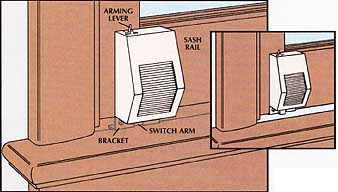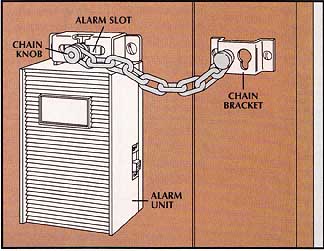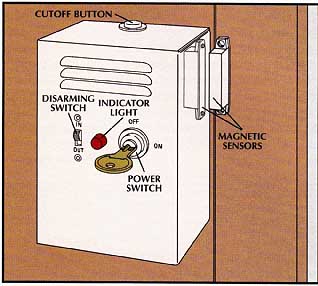A stranger approaches your home while you are away, slips to the side of the house, and starts to raise an unlocked window. A piercing alarm sounds, and the would-be intruder hurries away.
Protecting your home against intrusion need not require an elaborately wired system monitored by a security firm. Just as smoke detectors can give warning of a fire, screw-on alarms are adequate in low-crime areas.
The models shown here can be bought at hardware and electronic- equipment stores. Make sure to put in fresh batteries when you install them; then periodically test the de vices, and replace the batteries at least once a year.
Choosing the Right Unit: The most common intrusion alarm is a battery-operated protector that buzzes loudly when the door or window is opened.
A door-chain alarm can be set to sound only while you are inside the house. It makes enough noise to alert you and to frighten off most potential intruders, but one who stays long enough to see where the noise is coming from can silence the alarm simply by flicking the ON/OFF switch. More difficult to silence is the model opposite, which is set with a removable key. Although it's more costly, it also comes with a special disarming switch that lets you turn the protector on, then come and go without tripping the alarm.
A Canine Guardian: Many home owners rely on a family dog to alert them in case of fire or burglars— and some security consultants consider a dog the best protection of all. Follow the advice below to find a puppy suitable for both protection and family life.

A window buzzer.
• With the window open, push the prongs on the unit’s bracket up into the bottom rail of the lower window sash, then stick the bracket in place, using its adhesive backing strip.
• Close the window and set the arming lever to ON. The pressure of the window sill retracts a spring- loaded switch arm. If an intruder raises the window (inset), the switch arm is released and the alarm sounds.

A door-chain alarm.
• Mount the battery-powered alarm unit at the edge of the door about 18 inches above the doorknob.
• Set the chain knob at the center of the alarm slot, then position the chain bracket on the doorframe so that there is about inch of slack in the chain when the door is closed. Mount the bracket.
• Turn the unit on. When the door is opened, the chain pulls its knob to the side of the alarm slot. The knob then presses two electrical contacts together so that the alarm is activated and the buzzer sounds.

A locking door alarm.
Alarms vary, but the one shown at right is typical.
• Mount the alarm unit 18 inches above the door knob and about inch from the edge of the door.
• Position the magnetic sensor at the edge of the doorframe, inch below the top of the unit. The alarm sounds when contact is broken between the magnetic sensor in the alarm unit and the one on the doorframe.
• Turn on the alarm with the key and confirm that the indicator light is on.
• When everyone is in for the night, set the disarming switch to IN. The buzzer will sound if the door opens.
• To leave the house, move the switch to OUT. This gives an occupant 30 seconds to walk out the door and close it; if the door stays open longer, the buzzer will sound. Similarly, you can unlock and reenter the house without sounding an alarm, provided you don't leave the door open more than 30 seconds.
• While the alarm is on, use the cutoff button when you answer the door to keep the buzzer silent.
• Whenever the buzzer sounds, it will continue to do so until turned off with the key.
The Ultimate Alarm – A Family Dog?
Perhaps the most reliable security system is a living one—the family dog. Self-contained, requiring neither electricity nor installation, it can be trained to respond to most dangers or threats of danger. Most dogs will raise an alarm in response to intrusion or fire, but differences in temperament make some better watchdogs than others A dog with a very submissive temperament, for example, may hesitate to bark at intruders An extremely dominant dog, on the other hand, is not suited to a house with small children and can pose challenges to an inexperienced owner Look for a dog with a personality between these two extremes. If you are interested in a puppy ask an experienced breeder or dog trainer to assess its personality for you a process that is known as puppy testing You can often gauge the personality of an adult dog for yourself, but advice from a trainer or an experienced animal-shelter worker can help you match your house and family with the appropriate dog.
Once you have taken home a puppy or new dog, it will need only obedience training and loving care to develop the combination of qualities that make a good family watchdog. You can train a dog yourself at the obedience classes offered in many areas or with the help of one of the number of books available on the subject. Further protection training is unnecessary for family pets. Dogs that go beyond the sounding of an alarm to attack intruders are not recommended as family pets although some people living alone prefer aggressive “one man” dogs A dog trained to bite any hand that holds a weapon or attack any suspicious person is generally advisable only to protect commercial property.
Previous: Safes and Vaults for the HouseNext: A Network of Protection